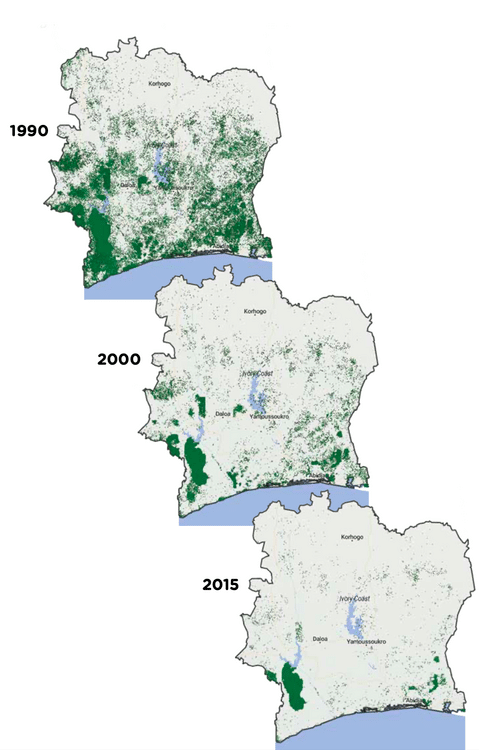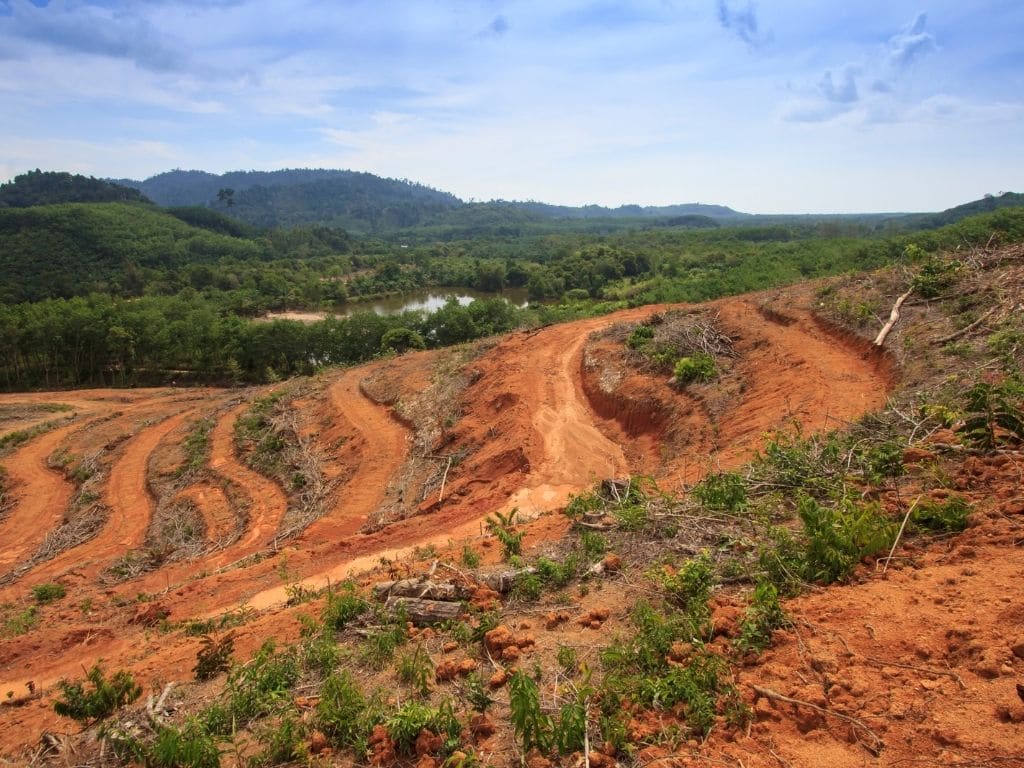26% of land in Africa is classified as forest and the continent is home to nearly 43 billion trees, the majority of which are found in South Africa, Ethiopia, and Nigeria. According to the UN Food and Agriculture Organization (FAO), nearly 4 million hectares of African forests are being cut down each year, at almost double the speed of the world’s deforestation average. We discuss the major causes of deforestation in Africa, its effects on the environment, as well as current policies and potential solutions to combat it.
—
Africa is one of the most diverse continents for land use, with the territory split between cropland, forests, grassland, wetland, and human settlements. Grassland and forests together make up more than 50% of the whole continent, while desert, barren, and unproductive areas – classified as ‘other land’ – represent 32.4% of the total land area.
Africa is the world’s third largest continent for global forest area, most of which is concentrated in central and southern countries characterised by a tropical climate like Zambia, Angola, Tanzania, and the Democratic Republic of Congo (DRC). The latter has the world’s second-largest rainforest: boasting an area five times the size of France and with nearly 152 million hectares of forests, the Congo Basin has been renamed the ‘lungs of the planet’.

At the same time, 66% of Africa is classified as dryland. Because of the hot and arid climate that characterises these desertic areas, tree coverage here is approximately 17% of the total land. While deforestation has decreased globally in recent years, the rate of loss of forest area in Africa has increased steadily since 1990, weakening the ability of the continent’s ecosystem to withstand climate change. Indeed, forests play a crucial role in maintaining a healthy and prosperous environment. They act as watersheds, defend the land against soil erosion, regulate local weather conditions, and trap greenhouse gases – a key element in the race against global warming. But what are the main causes of deforestation in Africa and what could save the continent from the devastating impacts of this phenomenon?
You could also like: How Does Deforestation Affect the Environment?
Causes of Deforestation in Africa
1. Agricultural Expansion
Worldwide, almost 80% of the total deforestation is caused by agricultural production. One of Africa’s biggest cash crops, cocoa, is responsible for forest clearings across the continent. Nearly three-quarters of the world’s cocoa is produced in four African countries: Côte d’Ivoire – the world’s single largest producer, Ghana, Nigeria, and Cameroon. Producing nearly 3 million tons of cocoa every year requires huge amounts of land. A report by the World Cocoa Foundation (WCF) and Mighty Earth found that one quarter of Côte d’Ivoire’s forests and 10% of Ghana’s trees have been cleared for cocoa production between 2001 and 2014, with nearly 40% of Ivorian plantations built illegally inside protected areas.

Another cheap and highly versatile and very profitable resource in Africa is palm oil. The continent accounts for 24% of the world’s palm oil, the majority of which is cultivated in the Central African country Cameroon. The expansion of this cash crop to meet global demand had devastating effects on the continent’s forests. It is estimated that nearly two-thirds of palm oil expansion occurred at the expense of forest due to (mainly unauthorised) land conversion.
2. Commercial Logging and Failing Government Policies
Only 24% of African forests are subject to long-term management plans, facilitating illegal logging and mining and thus the exploitation of timber. These practices have drastically accelerated the rate of destruction of primary forests. In the West African country Ghana, for example, deforestation increased by 60%. Trees are cut down to extract timber, typically used to build homes and furniture, and pulp, a crucial resource for the production of paper.
Logging also opens the way to mining as well as oil and gas extraction activities from international companies. An extreme example of this is the Democratic Republic of Congo: here, the government regularly issues illegal industrial logging concessions to local and foreign companies, violating forest conservation policies and accelerating the rate of deforestation in the country.
3. Charcoal Burning
An important driver of Africa’s deforestation is charcoal. Here, this inexpensive resource is the main cooking fuel for urban populations and, as these grow and demand for charcoal increases, deforestation intensifies. Aside from wood waste, charcoal production is also responsible for high carbon emissions. The most impacted African country is Zambia, where both rural and urban households heavily rely on charcoal as fuel for cooking and heating. Its production accounts for the main cause of forest destruction in the country, which has one of the highest deforestation rates in the world with a yearly loss of about 300,000 hectares of forested land.
4. Encroachment for Settlement
The increase in life expectancy, combined with the decreasing infant mortality, and high fertility rates, make the continent’s population the world’s fastest growing, with an annual growth rate of nearly 3%. Today, sub-Saharan Africa is home to 13% of the global population. However, with the number of people living in the region destined to double in the next few decades, estimates forecast that it will account for 35% of the global population at the end of the century. By looking at these numbers, it is not surprising that population growth is listed as one of the main causes of deforestation in Africa. Indeed, trees are cut down not only to create new settlements but also to extract raw materials needed to build houses and infrastructure.
How Does Deforestation in Africa Affect the Environment?
Deforestation in Africa has devastating impacts on the continent’s climate, ecosystems, and biodiversity. Many of the consequences are related to the continent’s ability to withstand the climate change challenge. Cutting down trees would reduce the forests’ ability to absorb carbon dioxide and generate rainfall, exposing territories to severe droughts and worsening the ongoing water crisis that has plagued Africa for decades. One of the countries mostly affected by severe droughts is Kenya in East Africa, where deforestation rates increased incrementally in recent years. Furthermore, a lack in soil cover would expose the terrain to soil erosion and degradation. It would also intensify the impact and frequency of floods. Indeed, forests act as sponges that soak up rainfall brought by tropical storms. When heavy rainfall occurs but there are not sufficient trees to absorb the water and anchor the soil, flooding is more likely to occur. Both soil erosion and flooding heavily compromise agricultural productivity and food security across the continent.
But the climate is not the only factor affected by deforestation. Biodiversity is also highly compromised by this practice and animals are some of the biggest victims, as they suffer habitat loss and lack of food. Among the animals threatened by deforestation in Africa is the pygmy elephant, with only around 30,000 individuals left in the world; the West Africa’s chimpanzee, which saw population numbers decreased by more than 80% over three generations and now faces a very high risk of extinction; the mountain gorilla, where only 1,000 of whom remain in the green volcanic slopes of Rwanda, Uganda and the DRC; and the West African lion, with a population just above 400 animals.
The Future of Deforestation in Africa
Rescuing Africa’s forests is crucial in order to maintain the country’s economic productivity and save it from the devastating consequences of global warming. According to the Food and Agriculture Organization of the United Nations (FAO), Africa contains more restorable lands than any other part of the world, with 393 million hectares of restoration opportunities for the Great Green Wall of Africa alone. The 520-million-hectares ‘Wall’ is composed of the three dryland regions North Africa, Sahel and Southern Africa, encompasses 25 countries and accounts for 17% of the African continent. The Great Green Wall Initiative, an ambitious plan was launched in 2007 to plant millions of trees across an 8,000km-long corridor in the Sahel to rescue the extremely vulnerable region from the devastating consequences of climate change. Planting trees, experts believe, could moderate temperatures, wind patterns and soil erosion as well as increasing humidity for agriculture. While the initiative had almost reached a standstill, a massive economic boost in 2021 brought new hope for the project’s completion.

However, the Great Green Wall is just one way to deal with some of the consequences brought about by phenomena such as deforestation. The best way to avoid them is to stop the destruction of forests in the first place. In the example of Africa, solutions include the regulation of the logging industry, the development of forest protection schemes and a variety of policies addressing human activities that promote this practice. Furthermore, attempts to deal with deforestation in the continent cannot ignore the problem of population growth. Thus, family planning policies will need to be undertaken as well.
You might also like: Water Crisis in South Africa: Causes, Effects, And Solutions
Certainly, governmental corruption will make things more difficult, as previous attempts to undermine the dangers of deforestation, such as the DRC-government decision to lift the 20-year-old logging moratorium safeguarding the Congo Basin, showed. However, there are some signs that the situation is changing. A huge step forward came at the COP26 in 2021, as the DRC President Félix Tshisekedi and UK Prime Minister Boris Johnson endorsed an ambitious 10-year agreement on behalf of the Central African Forest Initiative (CAFI) to protect the Congo Basin rainforest. The world’s largest forest carbon sink loses nearly half a million hectares of forest every year and at the current rate, experts fear that soon there will not be any primary forest left. Through multi-donor investments of USD$500 million, all sectors of the DRC’s economy will commit to cap forest loss, promote the regeneration of 8 million hectares of degraded forests and assign the protected status to almost 30% of national areas. While this is a good first step, much more effort is needed to stop deforestation and save Africa from climate change.
This story is funded by readers like you
Our non-profit newsroom provides climate coverage free of charge and advertising. Your one-off or monthly donations play a crucial role in supporting our operations, expanding our reach, and maintaining our editorial independence.
About EO | Mission Statement | Impact & Reach | Write for us




















